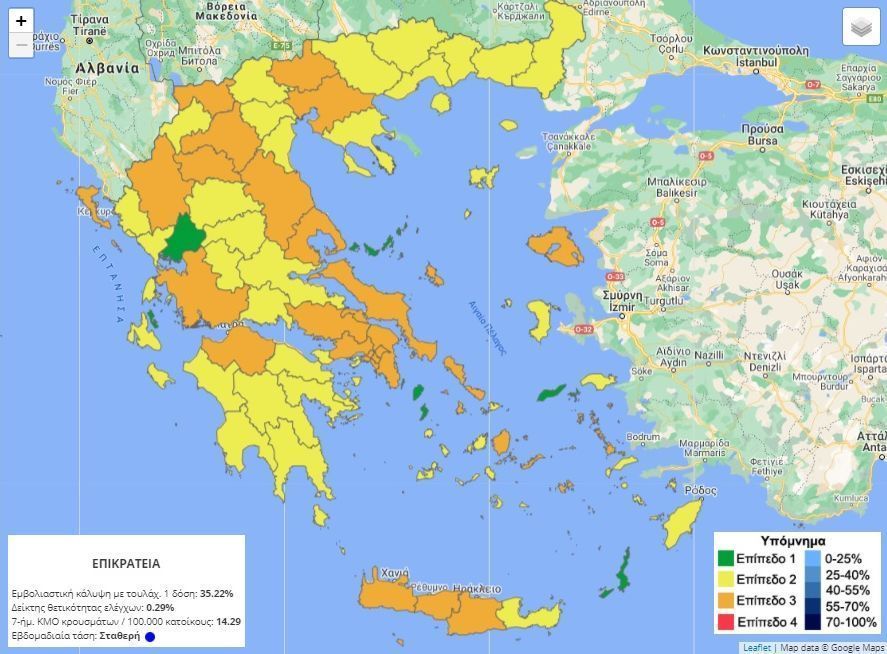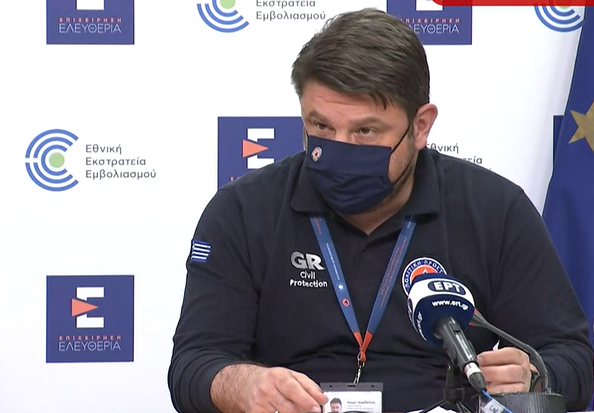Greece Updates Covid-19 Traffic Light Map to Show Risk Levels in Areas
The Greek government has introduced an updated version of its risk-assessment map that allows citizens and visitors to track the spread of the coronavirus (Covid-19) in the country and keep up to date with the latest safety restrictions by regional unit, municipality and island.
Presented on Friday by Greek Civil Protection Deputy Minister Nikos Hardalias, the map operates with the known four-tiered traffic light monitoring system and categorises Greece’s regions and municipalities as green, yellow, orange or red, on the basis of the risk levels associated with Covid-19 that are used by the European Center for Disease Control and Prevention (ECDC) and the World Health Organization (WHO).
As Hardalias informed, the map is aimed to provide guidance to Greeks and visitors in the country on health measures and restrictions on certain activities.
At the moment none of the country’s 74 regional units are in ‘red’ status, which is the most restrictive of the risk-assessment map.
However, the following 28 Greek regional units are currently in ‘orange’ status: Kilkis, Thessaloniki, Florina, Kozani, Ioannina, Grevena, Larissa, Magnesia, Etoloakarnania, Viotia, Evia, Achaia, Corfu, Chania, Rethymno, Heraklion, Naxos, Timos, Andros, Mykonos, Kalymnos, Lesvos and the regional units of Attica (except the islands).
All other regional units are in green or yellow status.
What happens if areas are ‘orange’ or ‘red’
Hardalias clarified that when an area is in ‘orange’ status, health authorities will increase testing for SARS-CoV-2, carry out on-site tracing and increase the number of vaccinations as a matter of priority
On the other hand, when an area goes ‘red’ on the map, the following restrictions will apply:
– Night curfew from 00:00 until 06:00
– All F&B establishments (restaurants, cafes, etc) will only operate in outside areas, serve only seated customers, not play music, disinfect menus each time customers change tables, provide a hand sanitizer product per table and masks must be worn by staff at all times and by customers when waited to be seated.
– All live events such as concerts, live parties, trade fairs, religious processions, farmer markets, etc, will be suspended.
– Public and private gatherings must not exceed 9 people for any reason.
– Tables at restaurants may seat up to 4 people (in case of families, up to 6 people are allowed).
– Construction work is suspended.
– All religious ceremonies are suspended with the exception of funerals and weddings with the presence of up to 9 people.
Greece’s color-coded risk-assessment map can be found here (in Greek). Press here for English.
The map will be updated on a weekly basis by the Health Ministry’s committee of experts in collaboration with the National Public Health Organization (EODY) and the General Secretariat for Civil Protection, taking into account a number of epidemiological indicators including the 14-day notification rate of new cases per 100,000 inhabitants for COVID-19, testing positivity rates, the number of active cases, the number of cases according to age, weekly number of new hospitalizations per 100,000 inhabitants, weekly number of deaths per 100,000 inhabitants and vaccination coverage rate.
For each regional unit/municipality the map will show the 7-day rate of cases per 100,000 inhabitants, the positivity rate, the vaccination coverage (at least one dose), and the weekly trend (up, down or steady).
Greek health authorities on Friday announced 1,112 new coronavirus cases and 34 deaths. Since the start of the pandemic, the total number of cases in the country has reached 407,857 with the death toll now at 12,218.









The rate of coronavirus in Greece is still too high. Greece must renew their efforts to bring that rate down. This is the truth that Greece must face up to, and quickly.